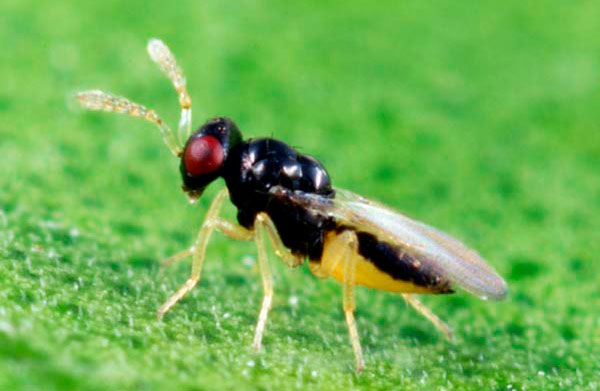This video with CDFA entomologist Dr. David Morgan and Santa Clara County agricultural commissioner Joe Deviney takes an up-close look at stingless wasp releases to protect against Asian citrus psyllids.
By Emily Harwitz
To prevent the spread of the devastating citrus greening disease, the California Department of Food and Agriculture is releasing thousands of flea-sized wasps into neighborhoods around Santa Clara County in January and February as part of their Citrus Pest and Disease Prevention program.
The teeny wasps, called Tamarixia radiata, while harmless to humans, are highly specialized predators of the invasive Asian citrus psyllid (ACP), which is responsible for spreading citrus greening disease, or Huanglongbing. Since it was first spotted in Florida in 2005, Huanglongbing has ravaged the state’s citrus industry and spread to other citrus-producing states, like Texas and California. Though it hasn’t yet been found in citrus groves or the Santa Clara region, ACP’s have — prompting the state’s agriculture department to take preventative action.
“If we control the vector — the psyllid — we control the spread of the disease,” said Victoria Hornbaker, CDFA’s citrus program director. Though Huanglongbing (HLB) has only been found in California so far in several southern counties, “we have been finding psyllids in Santa Clara County for a number of years,” she said. “Using Tamarixia radiata is one way of helping to control the Asian citrus psyllid.”
HLB is a disease caused by a bacteria that makes the phloem, or living tissue, of a plant crystallize, essentially choking off the flow of nutrients through the plant’s circulatory system. There is no known cure for HLB, so once a citrus tree is infected with HLB, it is destined to die.

California produces 80% of all the fresh citrus sold in the United States. If left unchecked, HLB carried by ACP could devastate the state’s $7 billion citrus industry like it did in Florida. So far, HLB has not breached any commercial citrus groves in California, thanks to the state’s aggressive approach.
“The first initial response was to treat everything with pesticides, and it didn’t work because the urban area is so diverse,” said Ivan Milosavljevic, who researches biological control at UC Riverside. “A lot of private residences tried that and (the local ecosystems) collapsed. The next step was to develop a biocontrol program where you introduce some natural enemies from the native range.”
Tamarixia radiata are native to areas of Pakistan with a similar climate to California. They’ve evolved over time to parasitize ACP’s, which themselves have evolved over time to feed specifically on citrus plants — all in an evolutionary feedback loop leading to intense specialization.
When UC Riverside researcher Mark Hoddle first collected the wasp in Pakistan and brought it back to the United States, the USDA tested the wasps extensively “in a huge quarantine facility (at UC Riverside),” Milosavljevic said, “with, of course, a lot of permits,” to ensure they wouldn’t harm any native bugs.
“Biological control is great because it is very, very specific if you choose the right insect,” said Dr. David Morgan, who oversees the CDFA’s biological control program.
The miniature though macabre relationship plays out “very much like the film ‘Aliens,’” Morgan described. Tamarixia radiata “lays an egg inside its host and then the egg will hatch out and eat the host alive.” And from there, it’s on to the next host for the tiny wasp, which has been known to fly up to 8 miles to locate their next ACP meal.
Over the past year, there have been about 30 detections of ACP in Santa Clara County, said Hornbaker. “Those detections have slowed as we’ve gone out and done our activities with treating and releasing biocontrol agents” — meaning that the little wasps are working.
The biological control program is a collaborative effort between the Citrus Research Board, University of California, CDFA, citrus growers, and vigilant homeowners who report when they find ACP on their trees and then cooperate with the CDFA’s measures, which sometimes means coming in and removing a diseased citrus tree.
Symptoms of a diseased tree include yellowing or blotchy leaves, yellow shoots, and bitter malformed fruit. An early or excessive fruit drop may also be a sign of HLB. ACP’s can often be spotted by their nymphs, which exude a white waxy string-like substance. Anyone who suspects their tree of having HLB, ACP’s, or both, is asked to call the CDFA’s free pest hotline: 800-491-1899.


